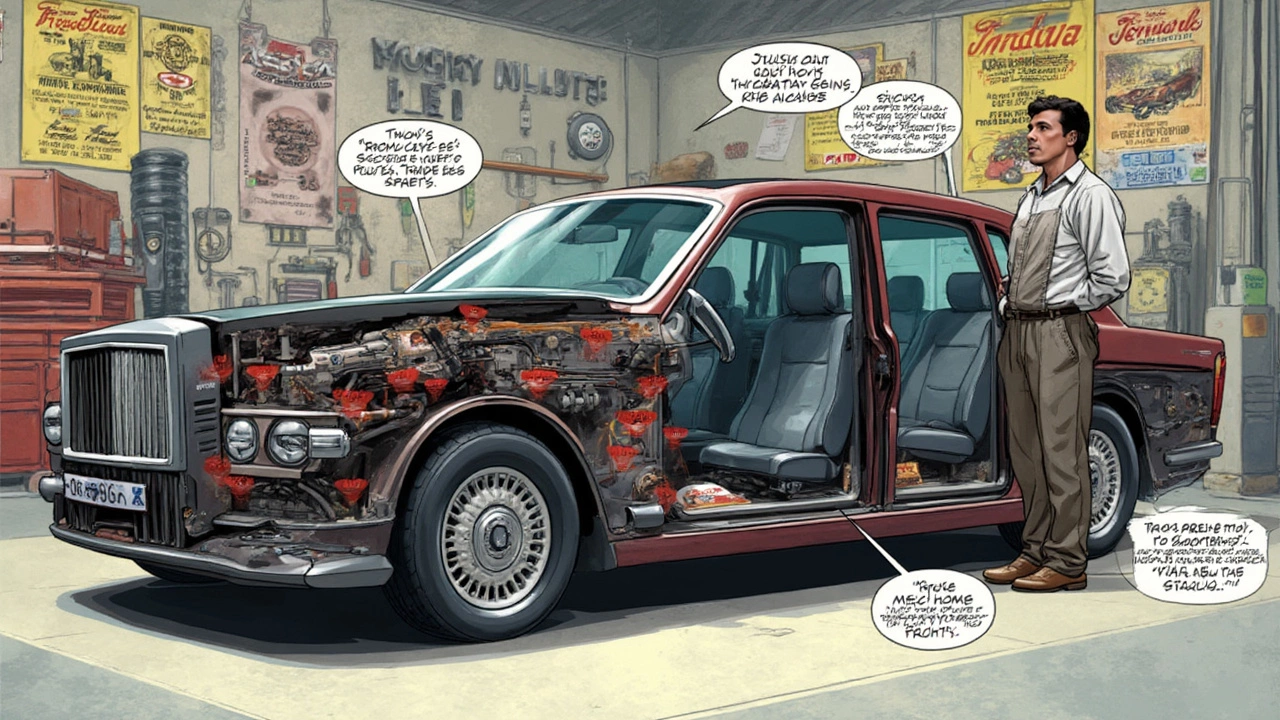Carbon Fiber Spoilers: The Drawbacks No One Talks About
 Jun, 1 2025
Jun, 1 2025
So, you’re thinking about slapping a carbon fiber spoiler on your ride. It’s hard not to get hooked by the look—lightweight, glossy, and just a bit aggressive. But are they really all upside? Plenty of folks are surprised once the excitement wears off and the real-life issues start showing up.
Let's get straight to it: carbon fiber isn’t some magical material that solves every problem. It might turn heads at the meet, but there are real drawbacks you should know before dropping hundreds—or even thousands—on a new spoiler. Dealers and online sellers love to talk up the performance boost, but they keep quiet about the things that can go wrong.
If you’re hoping for a spoiler that’s bulletproof, carefree, and cheap, you might want to hit the brakes a bit. I’ve seen more than one driver deal with cracks, fading, or fitment headaches they never saw coming. You’re not just paying for looks or a few extra pounds shaved off the scale—there can be some real annoyances hiding beneath the shiny finish.
- Sticker Shock: The Real Price of Carbon Fiber
- Cracks, Chips, and Sun Damage
- Installation and Compatibility Surprises
- Everyday Hassles and Maintenance
Sticker Shock: The Real Price of Carbon Fiber
Okay, here’s the first big wake-up call—carbon fiber spoilers don't come cheap. If you’re thinking about just pulling out your credit card and getting one off the shelf, be ready for a jolt. Compared to standard ABS plastic or fiberglass options, carbon fiber pieces cost two to three times more. It’s not rare to see a decent aftermarket carbon fiber spoiler running between $400 and $2,000, while the plastic ones hang out near the $100 mark.
The reason? Carbon fiber is crazy expensive to produce. Workers weave thin strands together by hand and then cure them under high heat using resin. It’s a time-consuming process—and mistakes mean tossing out a whole piece. Here’s a quick look at how prices stack up:
| Material | Average Price (USD) |
|---|---|
| ABS Plastic | $80 - $150 |
| Fiberglass | $120 - $300 |
| Carbon Fiber | $400 - $2,000+ |
And don’t forget about the “brand tax.” A carbon fiber spoiler from a big name like APR Performance or Seibon almost always costs way more than lesser-known brands. The fit and finish are usually better, but the price difference is real.
Replacement costs add up fast too. If your spoiler gets cracked or fades, repair isn’t cheap—sometimes, you just have to buy a new one because patch jobs stand out like a sore thumb.
"The process of making real carbon fiber parts is labor-intensive and costly. You’re paying for the materials and the skill," says Tech Editor Mike Garrett from Speedhunters.
The other thing most people miss? Shipping. These aren’t lightweight toy parts, and they’re awkwardly shaped, which bumps up shipping fees—sometimes $100 or more on top of the sticker price. That’s a tough pill to swallow when you’re budgeting for other mods.
If you’re tight on cash or just want a cool look, a carbon fiber spoiler might have you questioning if the bragging rights are really worth the investment. Don’t let the glossy finish blind you to the dent it’ll put in your wallet.
Cracks, Chips, and Sun Damage
Here’s a wake-up call: carbon fiber looks tough, but it’s not invincible. It’s actually pretty sensitive to impacts and rough weather. That glossy surface you love? It can get cracks or chips much quicker than classic plastic or metal spoilers. If a rock kicks up and hits just right—or you tap something in a parking lot—it doesn’t just scratch. With carbon fiber, it can spiderweb, split, or leave a white mark that screams for attention.
Direct sun isn’t a friend either. Without proper UV-protective clear coats, carbon starts to fade and yellow. Some guys have seen a fresh spoiler turn dull in less than a summer of bright days. Even high-end brands tell you to baby your new part. Here’s what Mike Holman, senior tech at StreetMod Performance, said when I asked about longevity:
“Carbon fiber needs more care than folks expect. A little sun and road grit can do real damage in a season or two, and the clear coat is crucial. Don’t skip waxing or park it in the sun for days on end.”
Just to give you a sense of what can go wrong, here’s what carbon fiber spoiler owners report most often:
- Chipping where rocks and debris hit at highway speed
- Cracks from minor bumps or even over-tightening bolts
- Yellowing or fading because of sunlight exposure
- Clear coat peeling after a year or two, especially on cheaper models
Want some real numbers? Check this out:
| Problem | Reported Incidents (per 100 owners, 2023 survey) |
|---|---|
| Surface Cracks | 32 |
| Chipping | 24 |
| Yellowing | 19 |
| Clear Coat Peeling | 11 |
Here’s a tip: if you skip regular waxing or just grab the cheapest carbon fiber spoiler off the internet, chances are you’re going to run into one (or all) of these issues. Spend the extra on a quality UV-resistant top coat, and don’t forget to actually take care of the thing—think of it like sunscreen for your car.

Installation and Compatibility Surprises
So you’ve picked out that shiny carbon fiber spoiler, your cart is full, and you’re ready to hit checkout. Here’s where a lot of folks trip up—installing these isn’t always plug-and-play. Even if the website says “universal fit,” don’t trust it blindly. Cars have slight differences between years, trims, and even models, so what bolts up perfectly on one might not on another.
Some spoilers require drilling right into your trunk or rear hatch. Not only does this make permanent changes to your car, but if you get the measurements even a little off, you’re left with ugly holes or a wobbly spoiler. Messing up can also leave your trunk more prone to water leaks or even rust if you don’t seal things right.
If your ride has built-in electronics, like rearview cameras, sensors, or a powered rear hatch, adding a spoiler can throw these systems out of whack. A lot of newer cars have tight tolerances, and a little extra weight or the wrong airflow pattern can set off warning lights or even impact how the trunk opens and closes. Double-check your owner’s manual or hit up an expert before you buy.
You'll also find that some carbon fiber spoilers ship as unfinished, meaning you need to spend extra for paint or clear-coating, and not all aftermarket shops know how to work with carbon fiber. It’s not the same as slapping fiberglass on your car. Any cracks or gaps that look harmless can lead to trouble at highway speeds. The last thing you want is to watch your expensive spoiler flap around—or, worse, go flying.
- Drilling is often required and leaves permanent marks.
- Waterproofing is key to prevent rust and leaks.
- Electronics might need adjustments or reprogramming.
- Unfinished spoilers add time and cost for painting or clear coating.
Here’s a quick look at some common compatibility headaches:
| Car Feature | Possible Spoiler Issue |
|---|---|
| Rearview Camera | Visual obstruction or image distortion |
| Trunk Sensors | Malfunctioning automatic opening/closing |
| Unibody Structure | Extra drilling can weaken the structure |
| Aftermarket Tail Lights | Restricted space for spoiler mounting |
Your best bet? Take your time measuring and see if you can find an install guide or video for your exact model before you buy. Don’t skip test-fitting if possible. It’ll save you a massive headache—and maybe a chunk of change, too.
Everyday Hassles and Maintenance
Here’s where reality really kicks in: owning a carbon fiber spoiler isn’t exactly “install and forget.” Keeping it looking good and holding up against regular use takes a lot more effort than most buyers expect. You can’t just treat it like cheap plastic and hope for the best, either.
First off, carbon fiber isn’t immune to the elements. Direct sunlight? That’s a real enemy—UV damage can make the resin turn yellow or cloudy in less than a year if the part isn’t finished with proper UV protection. Ever notice those cars with spoilers that look faded and patchy? That’s sun damage in action. The same goes for harsh winters; road salt can get into tiny cracks in the finish and start causing problems, sometimes even leading to delamination if water sneaks underneath.
The cleaning process is pickier, too. If you use the same soap or sponge on your carbon fiber spoiler as you do on your metal body panels, you risk scratching that shiny resin. Painful, right? For best results, you need a dedicated microfiber cloth, gentle car shampoo, and—if you’re fussy—a specialized carbon fiber sealant a few times a year.
- Skip the automatic car wash; the brushes can leave swirl marks and dull the glossy surface.
- If you catch small chips or cracks, fix them right away. Waiting means letting water or dirt make things worse.
- If you spot fading, a professional can sometimes polish it out, but deep yellowing usually means refinishing, which isn't cheap.
Want some numbers? Repairs for carbon fiber parts can cost more than twice what you'll pay for plastic or fiberglass fixes. Here’s a quick comparison:
| Repair Type | Average Carbon Fiber Cost | Average Plastic/Fiberglass Cost |
|---|---|---|
| Chip or Scratch Repair | $120-250 | $40-80 |
| Re-clearcoating (UV Damage) | $300-500 | $100-180 |
| Full Replacement | $800-1600 | $200-500 |
The bottom line? If you want your carbon fiber spoiler to stay in top shape, you’ll need to spend extra time (and money) on proper care. Don’t let sellers trick you into thinking otherwise—maintenance is just part of the deal if you want the look without the letdown.